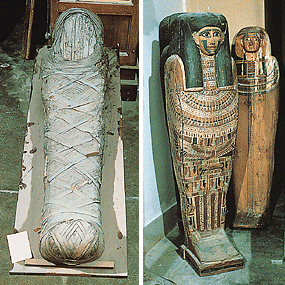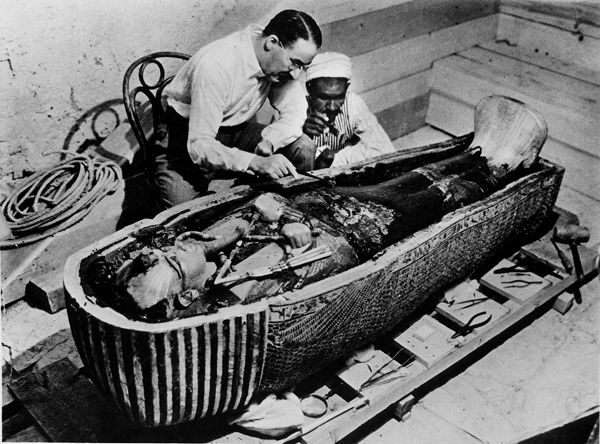Modern Mummy Created Using Ancient Method
The rediscovery of the process used by the ancient Egyptians to produce mummies more than 3,000 years ago was announced by British scientists on October 20, 2011. Chemist Stephen Buckley of the University of York in the United Kingdom reported that he and his co-workers had preserved the body of British taxi driver Alan Billis using the same techniques used to mummify the body of Tutankhamun (King Tut) and the bodies of other pharaohs of ancient Egypt. Buckley has spent nearly 20 years researching the mummification process used by the ancient Egyptians. Billis volunteered for the project after learning that he was dying of lung cancer.

Egyptian mummies were wound tightly with linen and then laid out in coffins. In some periods of Egyptian history, the coffins were painted. The Field Museum, Chicago.
Like ancient Egyptian embalmers, Buckley and his co-workers removed the lungs and intestines from Billis’s body through an opening cut in the left side of the abdomen. The cavity in his body was filled with linen. The researchers then soaked the body in a bath of natron, a powdery mixture that includes a harsh kind of salt, for three months. The natron dehydrated (removed all moisture from) the body. The researchers protected Billis’s skin with oils. They also wrapped the body in linen to protect it from light and insects.

British archaeologist Howard Carter discovered Tutankhamun's undamaged tomb in 1922. A magnificent lifelike gold mask of Tutankhamun covered the head and shoulders of the royal mummy, shown here as it is cleaned by Carter and an Egyptian assistant. © Getty Images.
In addition to reconstructing the mummification process in ancient Egypt, the project may help scientists develop preservation processes that do not use formaldehyde. Formaldehyde is the active ingredient in a solution used for embalming and for preserving insects and other biological specimens. Laboratory tests have shown that formaldehyde probably causes cancer.
Additional World Book articles:


